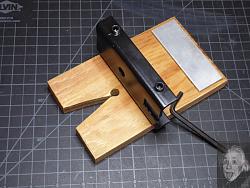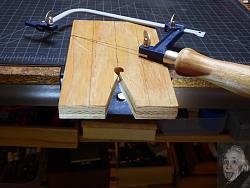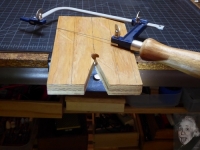In my thread on my improved Panavise hook...
Improved Panavise hook
I mentioned adding a birdsmouth to it but never got around to doing so. Later I reconsidered and decided that a stand-alone birdsmouth would be a better tool so this thread is about making that.
There are undoubtedly a few out there who don't know what a birdsmouth is so I'll explain briefly. It's a tool to assist in sawing out intricate patterns and piercings with a fret saw or a jeweler's saw in the case of metal parts. Basically, it's little more than a wooden plank with a slot or slots that can take many forms although the traditional is a narrow triangular slot which looks a bit like a bird's open mouth/bill, hence the name. The saw blade is set to cut on the pull stroke* and is used vertically through the slot with the work held on the plank. In some cases the plank is attached to a frame held in the bench vise to raise the plank to a more comfortable working position; often it attaches directly to the work table (my case) so it can be used by a seated sawyer.
I used 5/8" plywood for my plank with a traditional birdsmouth. In use it must be right in the center front of the worktable so it needs to be removable when not in use. I had some steel C-channel that just spans the thickness of my indoor worktable and the expendable fiberboard protector on it. This was drilled and tapped for two 3/8-16 setscrews to provide a clamping action. Conventional screws won't work here because if they project one can catch his legs/knees on them. Tightened down, the setscrews hardly project so they're the correct choice. I don't want fasteners projecting through the top of the plank so the channel was epoxied to the bottom of the plank. There's no appreciable strain on the joint so these joints should outlast me.
Clamped in place, the C-channel raises the bottom of the plank by the channel's thickness, 1/8", so, to prevent flopping, a piece of 1/8" aluminum scrap was epoxied to the rear of the plank.
Here's a picture of the birdsmouth in place, ready to work...
Give it some thought. There's limitless latitude here for expansion and modification to fit your particular work environment.
--
*Most Japanese handsaws are arranged to cut on the pull stroke and the Japanese are the hands-down champions of intricate wood joinery. Try it with your saws paying close attention to the motion of your forearm while sawing. I found sufficient improvement that I converted even my hacksaws to pull-cut. [Remember that old bromide about not being able to push a rope ?]


 LinkBack URL
LinkBack URL About LinkBacks
About LinkBacks




 Reply With Quote
Reply With Quote





Bookmarks